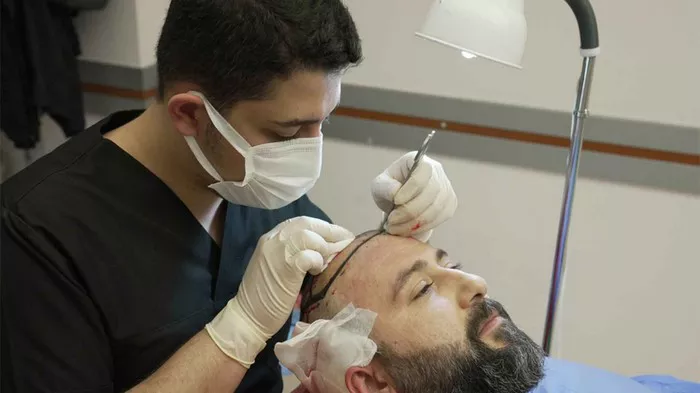Hair loss is a common concern for many individuals, affecting both their appearance and confidence. For those seeking a permanent solution, a hairline transplant has become a popular option. This procedure not only restores the hairline but also improves overall hair health and appearance. In this article, we will explore the results of a hairline transplant, what you can expect during recovery, and how proper hair care can enhance the outcomes.
What is a Hairline Transplant?
A hairline transplant is a surgical procedure designed to restore a receding or thinning hairline. It involves transplanting hair follicles from a donor area, usually the back or sides of the scalp, to the hairline. This procedure is ideal for individuals experiencing hair loss due to genetics, aging, or other factors.
The two most common techniques used are Follicular Unit Transplantation (FUT) and Follicular Unit Extraction (FUE). Both methods aim to create a natural-looking hairline while ensuring minimal scarring.
Why Choose a Hairline Transplant?
Many people opt for a hairline transplant because it offers long-lasting results. Unlike temporary solutions such as wigs or hairpieces, a hairline transplant provides a permanent fix. It also boosts self-esteem and allows individuals to style their hair without worrying about bald spots or thinning areas.
What to Expect Immediately After the Procedure
1. Swelling and Redness
After the procedure, it is normal to experience some swelling and redness around the treated area. This usually subsides within a few days.
2. Scabbing
Small scabs may form around the transplanted hair follicles. These scabs will fall off on their own within 7-10 days.
3. Mild Discomfort
Some patients report mild discomfort or soreness, which can be managed with prescribed pain medication.
The Healing Process: Week by Week
Week 1-2: Initial Recovery
During the first two weeks, the transplanted hair follicles will begin to settle into their new location. It is crucial to follow your surgeon’s aftercare instructions to ensure proper healing. Avoid touching or scratching the treated area to prevent infection.
Week 3-4: Shedding Phase
Around the third week, the transplanted hair may start to shed. This is a normal part of the process and should not cause concern. The hair follicles remain intact beneath the scalp and will eventually produce new hair.
Month 2-3: Early Growth
By the second or third month, you may notice tiny hairs beginning to grow. These hairs will initially be thin and fine but will thicken over time.
Month 6: Visible Results
At the six-month mark, the results of your hairline transplant will become more apparent. The hairline will look fuller and more natural.
Month 12: Final Outcome
After one year, the final results of your hairline transplant will be visible. The transplanted hair will blend seamlessly with your existing hair, creating a natural and youthful appearance.
Factors That Affect Hairline Transplant Results
1. Surgeon’s Skill
The success of a hairline transplant largely depends on the surgeon’s expertise. A skilled surgeon will design a hairline that complements your facial features and ensures natural-looking results.
2. Hair Health
The quality of your existing hair plays a significant role in the outcome. Healthy hair follicles are more likely to thrive after transplantation.
3. Aftercare
Proper aftercare is essential for achieving the best results. Follow your surgeon’s instructions regarding washing, styling, and protecting your scalp.
4. Lifestyle Choices
Smoking, excessive alcohol consumption, and poor nutrition can negatively impact the results of your hairline transplant. Adopting a healthy lifestyle can promote better hair growth.
How to Maintain Your Hairline Transplant Results
1. Follow a Hair Care Routine
Use gentle shampoos and conditioners to keep your scalp clean and healthy. Avoid harsh chemicals or heat styling tools that can damage your hair.
2. Protect Your Scalp from the Sun
Exposure to UV rays can harm your scalp and hair. Wear a hat or use a sunscreen specifically designed for the scalp when spending time outdoors.
3. Stay Hydrated and Eat a Balanced Diet
Proper hydration and nutrition are essential for maintaining hair health. Include foods rich in vitamins, minerals, and proteins to support hair growth.
4. Avoid Stress
Stress can contribute to hair loss. Practice relaxation techniques such as meditation or yoga to keep stress levels in check.
Common Myths About Hairline Transplants
1. Myth: Hairline Transplants Look Unnatural
Fact: When performed by a skilled surgeon, a hairline transplant can look completely natural. The key is to design a hairline that suits your face shape and hair type.
2. Myth: The Results Are Immediate
Fact: It takes time for the transplanted hair to grow and blend with your existing hair. Patience is essential during the recovery process.
3. Myth: Hairline Transplants Are Painful
Fact: The procedure is performed under local anesthesia, so you should not feel any pain during the surgery. Some discomfort may occur during recovery, but it is usually mild.
Who is an Ideal Candidate for a Hairline Transplant?
An ideal candidate for a hairline transplant is someone who:
- Has a receding or thinning hairline
- Has sufficient donor hair for transplantation
- Is in good overall health
- Has realistic expectations about the results
Conclusion
A hairline transplant can be a life-changing procedure for individuals struggling with hair loss. It not only restores the hairline but also improves overall hair health and appearance. By following proper aftercare and maintaining a healthy lifestyle, you can enjoy long-lasting results. If you are considering a hairline transplant, consult with a qualified surgeon to discuss your options and expectations.
Remember, hair care is an ongoing process. Whether you have undergone a hair transplant or not, taking care of your hair and scalp is essential for maintaining hair health and preventing further hair loss.
Related topics:
- 5 Best Hair Transplants in California: A Comprehensive Guide
- Hybrid FUE Hair Transplant: A Detailed Analysis


